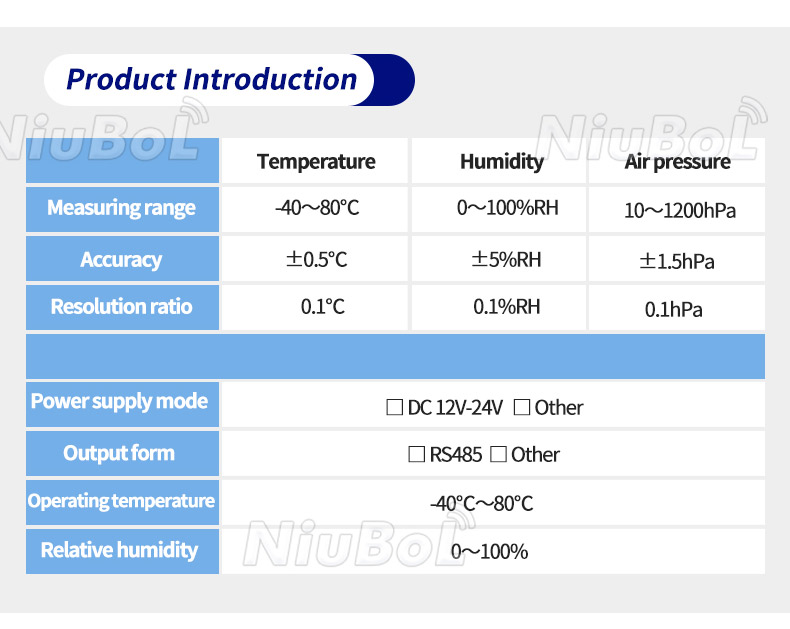

— Blogs —
—Products—
 Consumer hotline +8618073152920
Consumer hotline +8618073152920 WhatsApp:+8615367865107
Address:Room 102, District D, Houhu Industrial Park, Yuelu District, Changsha City, Hunan Province, China
Product knowledge
Time:2023-05-28 17:53:08 Popularity:2168
The working principle and application scenarios of temperature and humidity sensors
With the continuous development of technology, a variety of intelligent devices gradually into our lives, including temperature and humidity sensors is a very practical intelligent equipment. It can monitor the environmental temperature and humidity in real time, help us optimize the production and working environment, guarantee the quality of goods and save energy consumption. This article will introduce the working principle, common application sites and the role of temperature and humidity sensors.
A temperature and humidity sensor is a sensor that can measure the ambient temperature and humidity. Its working principle can be simply described as follows: it uses changes in the electrical characteristics of the temperature and humidity sensing elements to measure the ambient temperature and humidity.
In general, a temperature and humidity sensor contains a temperature sensing element and a humidity sensing element. The temperature-sensing element can be a thermocouple, thermistor or semiconductor temperature sensor, etc., which will produce changes in electrical characteristics such as resistance and voltage in response to changes in ambient temperature. The moisture-sensing element can be capacitive, resistive, conductive, etc., which will produce changes in electrical characteristics with changes in ambient humidity.

When the temperature and humidity sensor is exposed to the environment, the temperature-sensing element and the humidity-sensing element will generate the corresponding electrical signals according to the changes in ambient temperature and humidity. After these signals pass through the processing and amplification circuit inside the sensor, they can be read and processed by the processor to get the temperature and humidity data of the environment.
Temperature and humidity sensors are widely used in a variety of locations where temperature and humidity need to be monitored:
Agriculture: Temperature and humidity sensors can be used to monitor the temperature and humidity in greenhouses to help farmers control the greenhouse environment and ensure healthy plant growth. Also, it can be used to monitor the environment of rearing animals to ensure the production performance and health condition of animals.
Healthcare: Temperature and humidity sensors can be used for environmental monitoring in hospital operating rooms, ICUs, maternity wards for pregnant women and other places to ensure the health and safety of patients, newborns and other people.
Storage places: temperature and humidity sensors can be used for environmental monitoring of storage places such as food and medicine to ensure the quality and safety of stored items.
The role of temperature and humidity sensors is to monitor the ambient temperature and humidity in real time and transmit the data to the processor for processing and control. Through the accurate monitoring and control of environmental temperature and humidity, temperature and humidity sensors can serve the following purposes:

Ensure the safety of production and working environment: Temperature and humidity sensors can monitor the ambient temperature and humidity to detect environmental abnormalities in time and ensure the safety of production and working environment.
Improve production and work efficiency: Temperature and humidity sensors can optimize the production and work environment by monitoring and controlling the ambient temperature and humidity in real time to improve production and work efficiency.

Safeguard the quality of goods: Temperature and humidity sensors can monitor the temperature and humidity of the storage environment of goods to ensure the quality and safety of goods.
In short, temperature and humidity sensors play a very important role in various places, by real-time monitoring and control of environmental temperature and humidity to ensure the safety of the production and working environment, improve efficiency and the quality of goods, while also saving energy consumption.
If you are interested in temperature sensors, feel free to contact NiuBoL to bring you more information about digital agriculture and meteorological environment monitoring!
Prev:Soil temperature and moisture sensor prices and application scenarios
Next:Atmospheric temperature and humidity pressure sensor price and application scenarios
Related recommendations
Sensors & Weather Stations Catalog
Agriculture Sensors and Weather Stations Catalog-NiuBoL.pdf
Weather Stations Catalog-NiuBoL.pdf
Related products
 Combined air temperature and relative humidity sensor
Combined air temperature and relative humidity sensor Soil Moisture Temperature sensor for irrigation
Soil Moisture Temperature sensor for irrigation Soil pH sensor RS485 soil Testing instrument soil ph meter for agriculture
Soil pH sensor RS485 soil Testing instrument soil ph meter for agriculture Wind Speed sensor Output Modbus/RS485/Analog/0-5V/4-20mA
Wind Speed sensor Output Modbus/RS485/Analog/0-5V/4-20mA Tipping bucket rain gauge for weather monitoring auto rainfall sensor RS485/Outdoor/stainless steel
Tipping bucket rain gauge for weather monitoring auto rainfall sensor RS485/Outdoor/stainless steel Pyranometer Solar Radiation Sensor 4-20mA/RS485
Pyranometer Solar Radiation Sensor 4-20mA/RS485
Screenshot, WhatsApp to identify the QR code
WhatsApp number:+8615367865107
(Click on WhatsApp to copy and add friends)
